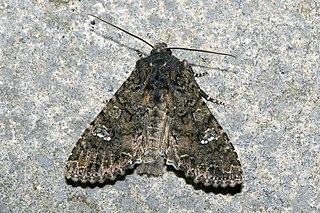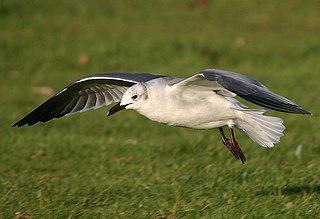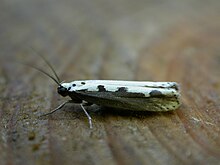
Aquilegia is a genus of about 60–70 species of perennial plants that are found in meadows, woodlands, and at higher altitudes throughout the Northern Hemisphere, known for the spurred petals of their flowers.

Caterpillars are the larval stage of members of the order Lepidoptera.

Lepidoptera is an order of insects that includes butterflies and moths. About 180,000 species of the Lepidoptera are described, in 126 families and 46 superfamilies, 10 per cent of the total described species of living organisms. It is one of the most widespread and widely recognizable insect orders in the world. The Lepidoptera show many variations of the basic body structure that have evolved to gain advantages in lifestyle and distribution. Recent estimates suggest the order may have more species than earlier thought, and is among the four most speciose orders, along with the Hymenoptera, Diptera, and Coleoptera.

Moths are a paraphyletic group of insects that includes all members of the order Lepidoptera that are not butterflies, with moths making up the vast majority of the order. There are thought to be approximately 160,000 species of moth, many of which have yet to be described. Most species of moth are nocturnal, but there are also crepuscular and diurnal species.

The Noctuidae, commonly known as owlet moths, cutworms or armyworms, are the most controversial family in the superfamily Noctuoidea because many of the clades are constantly changing, along with the other families of the Noctuoidea. It was considered the largest family in Lepidoptera for a long time, but after regrouping Lymantriinae, Catocalinae and Calpinae within the family Erebidae, the latter holds this title now. Currently, Noctuidae is the second largest family in Noctuoidea, with about 1,089 genera and 11,772 species. However, this classification is still contingent, as more changes continue to appear between Noctuidae and Erebidae.

Prunus virginiana, commonly called bitter-berry, chokecherry, Virginia bird cherry, and western chokecherry, is a species of bird cherry native to North America. The natural historic range of P. virginiana includes most of Canada, most of the United States, and northern Mexico.

The cabbage moth is primarily known as a pest that is responsible for severe crop damage of a wide variety of plant species. The common name, cabbage moth, is a misnomer as the species feeds on many fruits, vegetables, and crops in the genus Brassica. Other notable host plants include tobacco, sunflower, and tomato, making this pest species particularly economically damaging.

Vagrancy is a phenomenon in biology whereby individual animals appear well outside their normal range; individual animals which exhibit vagrancy are known as vagrants. The term accidental is sometimes also used. There are a number of factors which might cause an individual to become a vagrant—genetic factors and weather conditions are two—but the causes are overall poorly understood. Vagrancy can be a precursor to colonisation if individuals survive.

Schinia, commonly called flower moths, is a large genus of moths belonging to the family Noctuidae. The genus has a Holarctic distribution with the vast majority of species being found in North America, many with a very restricted range and larval food plant.

The leek moth or onion leaf miner is a species of moth of family Acrolepiidae and the genus Acrolepiopsis. The species is native to Europe and Siberia, but is also found in North America, where it is an invasive species. While it was initially recorded in Hawaii, this was actually a misidentification of Acrolepiopsis sapporensis.
Numata is a genus of moth in the family Gelechiidae. It contains the species Numata bipunctella, which is found in North America, where it has been recorded from Texas.

The map-winged swift is a moth belonging to the family Hepialidae. The species was first described by Charles De Geer in 1778. It has a patchy distribution throughout Eurasia. It was previously placed in the genus Hepialus and some references still place it there.
Haplochrois is a genus of moths in the family Elachistidae, though some classifications place it in the Agonoxenidae, Coleophoridae or Cosmopterigidae.
Coenochroa bipunctella, the sand dune panic grass moth, is a species of snout moth in the genus Coenochroa. It was described by William Barnes and James Halliday McDunnough in 1913, and is known from the United States, including Florida, Arizona and Maryland.
Ethmia iranella is a moth in the family Depressariidae. It has been recorded from Asia Minor, Syria, Iran, Spain, Portugal, Hungary, Romania, Greece and southern Russia. It has recently been recorded from France and Italy.
Mampava bipunctella, the foxtail millet webworm, is a species of snout moth, and the type species in the genus Mampava. It was described by Émile Louis Ragonot in 1888, and is known from India, Papua New Guinea, Malaysia (Sarawak), Taiwan, China, the Moluccas, Indonesia and Japan.
Haplochrois bipunctella is a moth of the family Elachistidae. It is found in North America, including Arizona, Mississippi, New Mexico, Oklahoma and Texas.

Glaucocharis bipunctella is a moth in the family Crambidae. It was described by Francis Walker in 1866. It is endemic to New Zealand.
Ornativalva mixolitha is a moth of the family Gelechiidae. It was described by Edward Meyrick in 1918. It is found in Morocco, Algeria, Tunisia, southern Russia, Turkey, Sudan, Iraq, Iran, Afghanistan, Pakistan, India (Bihar) and Mongolia.
Xylorycta bipunctella is a moth in the family Xyloryctidae. It was described by Francis Walker in 1864. It is found in Australia.














